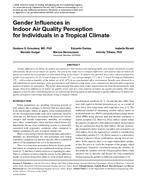-
-
Available Formats
- Options
- Availability
- Priced From ( in USD )
-
Available Formats
-
- Immediate download
- $16.00
- Add to Cart
Customers Who Bought This Also Bought
-

IAQ 2007: Healthy and Sustainable Buildings -- Conference...
Priced From $83.00 -

Gender Influences in Indoor Air Quality Perception for In...
Priced From $16.00 -

Mixed Lung Disease in School Teachers: An Outbreak
Priced From $16.00 -

Field Test of Room-to-Room Distribution of Outside Air wi...
Priced From $16.00
About This Item
Full Description
One of the most common indoor air contaminants is formaldehyde, which is emitted by a number of possible sources. Construction materials, adhesives, tobacco smoke and unvented combustion are some of the most common sources. Urea-formaldehyde adhesives and resins are often used in the construction of wood products and can be a major source. The infiltration of outdoor air is not typically a significant source of formaldehyde. Formaldehyde is a strong irritant, affecting some people at concentrations below 0.1 ppm, and it is a known carcinogen. Significant reductions in the formaldehyde concentration have been made by restricting the amount of formaldehyde that is emitted by construction materials over the last few years. Further reductions in the concentration of formaldehyde are possible with the use of a portable air treatment system that has a proprietary catalytic bed which is capable of removing formaldehyde from indoor air. However, there are no standard test methods for determining the reduction of a compound such as formaldehyde under realistic conditions. Since some of the technologies, such as activated carbon, used in portable air treatment systems may have good short term performance but poor long-term performance, a test method is needed that will determine short and long-term performance. A method has been developed that determines the performance of a portable air treatment system for the reduction of an indoor contaminant, over the rated life of the filter. The test method has three steps, initial performance, an accelerated filter loading that simulates months of exposure to the contaminant and a final performance test. The test method uses criteria based on real life occurrence levels for formaldehyde in homes. The accelerated loading portion of the method exposes the product to four months of life in a two week test period. The resulting test method has application for testing for a number of possible indoor air contaminants.
IAQ 2007 Conference held in Baltimore, Maryland, October 14-17, 2007
Units: SI





